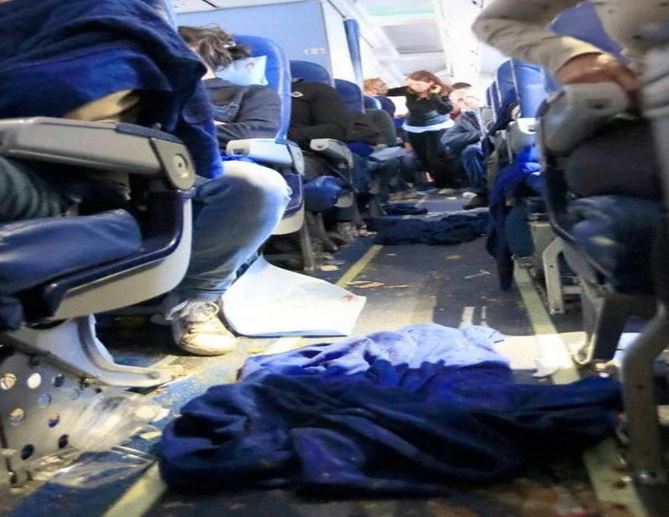Climate change is contributing to hotter heat waves and more damaging storms. When it comes to air travel, these events can lead to delays, can- cellations and bumpier skies, as if our world wasn’t turbulent enough already.
At hotter temperatures, planes need to go faster to take off due to lower air density. In extreme heat, planes might not have enough runway to get the speed they need to go airborne. That
heat can ground aircraft: A 119-degree day in 2017 led American Airlines to cancel more than 40 flights out of Phoenix.
Scientists are studying climate changes effects on jet streams – bands of air currents – and are noting stronger variations in wind speed, which can cause more severe turbulence. Paul Williams, a noted atmospheric scientist at the University of Reading in Britain, calculated in a 2017 study that climate change could boost incidents of severe turbulence by 149 percent within a decade.
“Even the most seasoned frequent fliers may be alarmed at the prospect of a 149 percent increase in severe turbu- lence”, said Paul Williams, atmospheric scientist. High temperatures on the tarmac can lead to heat stress and other illnesses associated with extreme work- ing conditions.
During hot weather, concrete and asphalt turn into “heat islands” – spots that are hotter than the surrounding areas – making airport employees es- pecially vulnerable. Scientists are con- fident that continued warming threat- ens human health, potentially making working outdoors impossible in many regions.
Heat or flooding can make airports in- operable. When temperatures soar to- ward 100 degrees Fahrenheit, tarmacs can get soft and cause the wheels of planes to get stuck. In addition to ex- treme heat, climate change – triggered by humans – is contributing to rising sea levels, which are leading to higher storm surges and more floods.
Turbulence
Turbulence is one of the most unpre- dictable of all the weather phenomena that are of significance to pilots. Turbu- lence is an irregular motion of the air resulting from eddies and vertical cur- rents. It may be as insignificant as a few annoying bumps or severe enough to momentarily throw an airplane out of control or to cause structural damage.
Turbulence is associated with fronts, wind shear, thunderstorms, and all are increasing at alarming rates, some would attribute to climate changes and more erratic and unpredictable weather events.
Mechanical Turbulence
Friction between the air and the ground, especially irregular terrain and man-made obstacles, causes eddies and therefore turbulence in the lower levels.
The intensity of this eddy motion de- pends on the strength of the surface wind, the nature of the surface and the stability of the air. The stronger the wind speed (generally, a surface wind of 20 knots or higher is required for significant turbulence), the rougher the terrain and the more unstable the air, the greater will be the turbulence. Of these factors that affect the formation of turbulence, stability is the most important. If the air is being heated from below, the vertical motion will be more vigorous and extensive and the choppiness more pronounced. In un- stable air, eddies tend to grow in size; in stable air, they tend not to grow in size but do dissipate more slowly.
Strong winds are usually quite gusty; that is, they fluctuate rapidly in speed. Sudden increases in speed that last several minutes are known as squalls and they are responsible for quite severe turbulence.
Thermal (Convective) Turbulence
Turbulence can also be expected on warm summer days when the sun heats the earth’s surface unevenly. Certain surfaces, such as barren ground, rocky and sandy areas, are heated more rap- idly than are grass covered fields and much more rapidly than is water. Iso- lated convective currents are therefore set in motion with warm air rising and cooler air descending, which are re- sponsible for bumpy conditions as an airplane flies in and out of them.
Turbulence extends from the base to the top of the convection layer, with smooth conditions found above. if cumulus, towering cumulus or cumu- lonimbus clouds are present, the turbu- lent layer extends from the surface to cloud tops.
Turbulence intensity increases as con- vective updraft intensity increases.
In weather conditions when thermal activity can be expected, many pilots prefer to fly in the early morning or in the evening when the thermal activity is not as severe. Convective currents are often strong enough to produce air mass thunder- storms with which severe turbulence is associated. Turbulence can also be expected in the lower levels of a cold air mass that is moving over a warm surface. Heating from below creates unstable conditions, gusty winds and bumpy flying conditions.
Thermal turbulence will have a pro- nounced-effect on the flight path of an airplane approaching a landing area.
The airplane is subject to convective currents of varying intensity set in mo- tion over the ground along the approach path. These thermals may displace the airplane from its normal glide path with the result that it will either over- shoot or undershoot the runway.
Frontal Turbulence
The lifting of the warm air by the slop- ing frontal surface and friction between the two opposing air masses produce turbulence in the frontal zone. This turbulence is most marked when the warm air is moist and unstable and will be extremely severe if thunderstorms develop.
Wind Shear
Wind shear is the change in wind direction and/or wind speed over a specific horizontal or vertical distance. Atmospheric conditions where wind shear exists include: areas of tempera- ture inversions, along troughs and lows, and around jet stream. When the change in wind speed and direction is pronounced, quite severe turbulence can be expected. Clear air turbulence is associated at high altitudes (i.e, above 15,000 feet AGL) with the jet stream.
The greatest shear, and thus the great- est turbulence, is found at the tops of the inversion layer. Turbulence associ- ated with temperature inversions often occur due to radiational cooling, which is nighttime cooling of the Earth’s sur- face, creating a surface-based inversion.
Turbulence associated with lows and troughs is due mainly to horizontal directional and speed shear. Turbulence is generally found along troughs at any altitude, within lows at any altitude, and poleward of lows in the mid and upper altitudes.
A jet stream is core of strong horizontal winds that follows a wavelike pattern as a part of the general wind flow. It is located where there are large horizon- tal differences in temperature between warm and cold air masses.
Meanwhile, many airports are located in flat, coastal areas or in vulnerable floodplains where extreme storms can inundate runways. Weather causes about a third of flight delays, according to federal statistics. Delays overall cost industry and passengers billions a year.
One reason passengers take such a financial hit: Airlines consider weather an “act of God” out of their control. It’s up to them whether to offer refunds or compensation. Scientists say climate change will likely bring more and in- creasingly intense storms, which could lead to more delays and cancellations in the coming years.
While more planes are coming into service, the global aviation industry, which accounts for 2 percent of global carbon dioxide emissions, is taking initial steps to reduce emissions. What we need to do now is demand action– from leaders at every level – while urging companies to adopt sustainable business practices.
Turbulence, in all shapes and forms may be here to stay and we are in for a bumpy ride. It does help to under- stand it scientifically while keep our
seat-belts on and seats in their upright position!
By The Environmental Defense Fund & Wayne Carley




